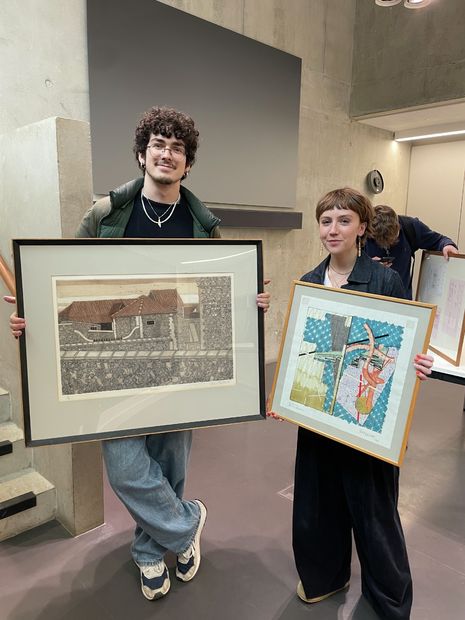Anything goes at the Kettle’s Yard picture scheme
Ronan McAuliffe speaks to the students who braved the queue for the gallery’s ‘art for students’ scheme, asking: can you ever know what you’re looking for?

Jim and Helen Ede had more pictures than they had wall space. Students would visit, and on leaving might take one with them, to brighten up a gloomy set. Nowadays, Kettle’s Yard’s ’Art for Students’ scheme has about 100 pieces, which staff lay out on long tables in groups of about 40, with the remainder lying against the walls, coming to fill in the gaps later on.
“You can’t always get what you want”
If you’re Jim Ede, you think art transforms lives, but it can only do so when people are looking at it, so a standing collection provides no value. Past exhibitions, old wall-stock, and even some promotional material from shows gone by make it into the student loan scheme.
You can’t always get what you want. The structure of the scheme imposes a harsher and truer sentence than that: you don’t even know what you want. This was the continual lesson learned on the day. At the door I met a man who wanted, in clear terms, something big, bright, “pleasurable”, free, joyous and optimistic. He came out of the hall grinning, and so I asked to see what he had taken that had satisfied him so greatly. Two monochrome black and white woodcuts. One titled The Burning Tree (Hell), the other even more miserable.

Another student said he wanted two contrasting paintings for his set. One, “pleasant,” in the lounge, and another “despairing,” in the bedroom. Not just looking for wall-hangings, either — both paintings should say something to their owner. “Pleasant in the lounge, despairing in the bedroom,” he said. On second thoughts, perhaps it was so that the paintings would “speak to their owner” … In either case, he certainly succeeded, coming out brandishing two big pieces, one horrible, ghoulish, dark and lumpen, and the other airy and colourful, bright straight lines on white in the manner of Kandinsky.
Another student told me that she wanted something bleak, a little provocative and distressing, yet came out with a grass-green abstract expressionist piece resembling an unfinished jigsaw puzzle of a sunny lawn, almost jumping with enthusiasm. It is therefore clear: while the scheme might not give you what you want, it is very good at reminding you that you don’t have a clue what you want, and that there is more in the world than is contained in your preference.
“Somebody liked it enough to buy it, so trust that your taste is not fixed”
At risk of generalising to the point of incoherence (a fear one should never allow to become an obstacle to good hack sociology) this model is at odds with the way most art is experienced these days. Taste is a rarefaction (a rarefaction often taught and encouraged on the courses in this very university), and the mark of good taste is an incapacity to engage with that which falls below the mark, and those people with the very best taste can hardly endure anything. Think Ruskin, the ideal of Proper English Taste, so rarified he couldn’t stand to be in a room with a Whistler, or Wittgenstein, undisputed champion of the Cambridge’s Cleverest Ever Boy Contest, so tasteful that he shuddered at the vulgarity of music you or I might call a masterpiece — is there anything more brilliantly haughty?
Kettle’s Yard declares that every piece in their collection deserves to be hung on a wall, and that your haughtiness isn’t worth a damn. Somebody liked it enough to buy it once upon a time, so trust that your taste is not fixed or true, accept something strange or obscure into your life, enjoy a peculiar piece, or learn to wake up looking at it anyway. Less choice forces a more direct involvement with each piece, since the punter is unable to write anything off for its school, subject, or style out of the gate.
This unforgiving approach to taste has its drawbacks, though, and while nobody is perfectly catered to by the process, some people aren’t catered to at all. It’s a first-come-first-served system, and when the klaxon sounded for last pictures, a line of around a hundred still stretched around the building and up Castle Street, left to shuffle sadly back down the hill to their bare, miserable rooms. In a testament to the voracious and multifarious appetites of Cambridge’s viewing public, when the paintings ran out, only three stood by untaken: a purple cross on a black background, and two of red block patterns on white, like pixellated candy-canes. After five minutes, these had gone too. At Kettle’s Yard, anything goes.
 News / Pembroke to convert listed office building into accom9 December 2025
News / Pembroke to convert listed office building into accom9 December 2025 News / Gov declares £31m bus investment for Cambridge8 December 2025
News / Gov declares £31m bus investment for Cambridge8 December 2025 Features / Searching for community in queer Cambridge10 December 2025
Features / Searching for community in queer Cambridge10 December 2025 News / Uni redundancy consultation ‘falls short of legal duties’, unions say6 December 2025
News / Uni redundancy consultation ‘falls short of legal duties’, unions say6 December 2025 Lifestyle / Into the groove, out of the club9 December 2025
Lifestyle / Into the groove, out of the club9 December 2025









